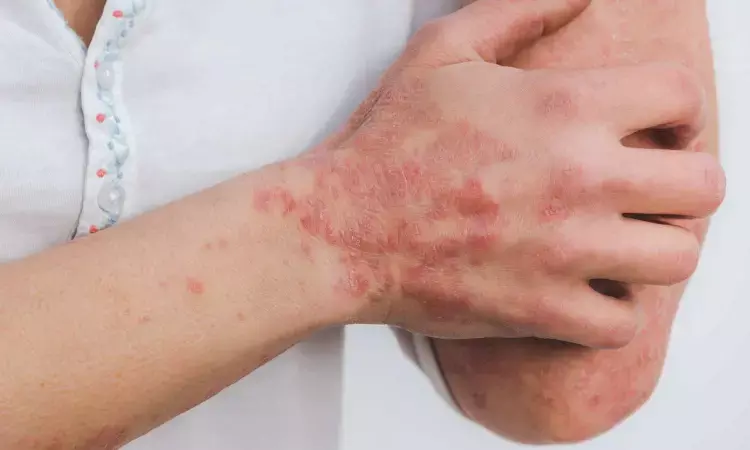- Home
- Medical news & Guidelines
- Anesthesiology
- Cardiology and CTVS
- Critical Care
- Dentistry
- Dermatology
- Diabetes and Endocrinology
- ENT
- Gastroenterology
- Medicine
- Nephrology
- Neurology
- Obstretics-Gynaecology
- Oncology
- Ophthalmology
- Orthopaedics
- Pediatrics-Neonatology
- Psychiatry
- Pulmonology
- Radiology
- Surgery
- Urology
- Laboratory Medicine
- Diet
- Nursing
- Paramedical
- Physiotherapy
- Health news
- Fact Check
- Bone Health Fact Check
- Brain Health Fact Check
- Cancer Related Fact Check
- Child Care Fact Check
- Dental and oral health fact check
- Diabetes and metabolic health fact check
- Diet and Nutrition Fact Check
- Eye and ENT Care Fact Check
- Fitness fact check
- Gut health fact check
- Heart health fact check
- Kidney health fact check
- Medical education fact check
- Men's health fact check
- Respiratory fact check
- Skin and hair care fact check
- Vaccine and Immunization fact check
- Women's health fact check
- AYUSH
- State News
- Andaman and Nicobar Islands
- Andhra Pradesh
- Arunachal Pradesh
- Assam
- Bihar
- Chandigarh
- Chattisgarh
- Dadra and Nagar Haveli
- Daman and Diu
- Delhi
- Goa
- Gujarat
- Haryana
- Himachal Pradesh
- Jammu & Kashmir
- Jharkhand
- Karnataka
- Kerala
- Ladakh
- Lakshadweep
- Madhya Pradesh
- Maharashtra
- Manipur
- Meghalaya
- Mizoram
- Nagaland
- Odisha
- Puducherry
- Punjab
- Rajasthan
- Sikkim
- Tamil Nadu
- Telangana
- Tripura
- Uttar Pradesh
- Uttrakhand
- West Bengal
- Medical Education
- Industry
Linoleic acid linked with hypersensitivity to temperature and pain in psoriasis plaques

USA: A recent study has found that a common fatty acid may contribute to increased temperature and pain but not itch-sensitivity in psoriatic lesions. The finding could better understand how lipids communicate with sensory neurons and potentially improve pain and sensitivity treatments for psoriasis patients.
Linoleic acid is a fatty acid found in vegetable oils, nuts and seeds and one of the predominant fatty acids in the Western diet. Metabolites from linoleic acid-the products formed when the body breaks it down through digestion-play a role in skin barrier function.
“We noticed high levels of two types of lipids derived from linoleic acid in psoriatic lesions,” says Santosh Mishra, associate professor of neuroscience at North Carolina State University and corresponding research author. “That led us to wonder whether the lipids might affect how sensory neurons in these lesions communicate. We decided to investigate whether their presence could be related to the temperature or pain hypersensitivity that many psoriasis patients report.”
The research team used mass spectrometry to create lipid profiles of skin from psoriatic lesions. They focused on two types of linoleic acid-derived lipids, or oxylipids: 13-hydroxy-9,10-epoxy octadecenoate (9,13-EHL) and 9,10,13-trihydroxy-octadecenoate (9,10,13-THL). The first form, 9,13-EHL, can convert into the more stable 9,10,13-THL form via interaction with certain enzymes.
The researchers found that while both forms bind to receptors on sensory neurons within the skin, the more stable form – 9,10,13-THL – had a longer lasting effect than 9,13-EHL.
They also found that once the lipids bind to the neuronal receptor, they activate the neurons expressing TRPA1 and TRPV1 receptors that are involved in temperature and pain hypersensitivity, opening communications channels to the central nervous system.
Interestingly, the lipids did not have any effect on itch.
“It was surprising that these lipids could create hypersensitivity but not impact itch sensation, which is usually the most troublesome symptom associated with psoriasis,” Mishra says. “This most likely has to do with how the neuron is activated – a mechanism we still haven’t uncovered.”
Now that an association between linoleic acid and hypersensitivity to temperature and pain has been established, the researchers want to explore exactly how this response is being created. They hope the answers may lead to solutions that can relieve these symptoms in psoriasis patients.
“We know this lipid moves from one form to another but don’t yet know what causes that,” Mishra says. “We also know what protein the lipids bind to, but not where the bond occurs. Answering these questions may hopefully lead to new therapies-or dietary solutions for some psoriasis sufferers.”
Reference:
Joshua J. Wheeler, Anthony F. Domenicheillo, Jennifer R. Jensen, Gregory S. Keyes, Kristen M. Maiden, John M. Davis, Christopher E. Ramsden, Santosh K. Mishra Published:December 25, 2022 DOI: https://doi.org/10.1016/j.xjidi.2022.100177
Dr Kamal Kant Kohli-MBBS, DTCD- a chest specialist with more than 30 years of practice and a flair for writing clinical articles, Dr Kamal Kant Kohli joined Medical Dialogues as a Chief Editor of Medical News. Besides writing articles, as an editor, he proofreads and verifies all the medical content published on Medical Dialogues including those coming from journals, studies,medical conferences,guidelines etc. Email: drkohli@medicaldialogues.in. Contact no. 011-43720751


